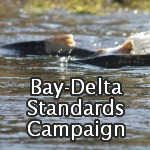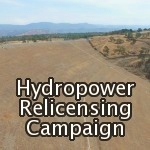On April 2, 2024, Governor Gavin Newsom announced the release of the 2023 update of the California Water Plan (Water Plan). Governor Newsom announced the Water Plan at a press conference held at Phillips Station in the high Sierra, just after this year’s snowpack was measured there at 113 percent of average.
At the press conference, Governor Newsom stated that the Water Plan contains a new strategy to help California adapt to future cycles of extreme drought and extreme precipitation. At the core of this strategy is the plan to build Sites Reservoir for more storage and the Delta tunnel for more conveyance. The Water Plan also supports the weakening of regulations that could be used to keep more water in rivers to protect public trust resources.
The update of the Water Plan offers no reckoning with the fact that the state constantly promises and delivers more water than falls from the sky or is left in the ground. Rather, the Water Plan outlines a strategy that will continue the same overallocation of the state’s water resources that has led to the near collapse of ecosystems in the Bay-Delta, its tributaries, and beyond.
The Water Plan’s Backward Reasoning
Chapter 3 of the Water Plan describes how healthy watershed ecosystems play a crucial role in “enhancing adaptation to climate change, and ensuring long-term resilience for built infrastructure.”
Chapter 2 of the Water Plan details the destructive force California’s past water management has had on these ecosystems stating, “Reclamation has eliminated most of the state’s historical wetlands. Reduced stream flows, increased temperatures, lack of habitat, pollution, and proliferation of invasive species have affected many fish species across the state. Native fish and wildlife evolved to cope with drought, but prolonged dry periods are increasingly stressful because many streams warm, lessen, or dry up. In many areas, fish and wildlife exposure to these dry periods is often extended or amplified by consumptive water use.”
The Water Plan update doubles down on supplying more water to the unsustainable practices of relentless impoundment and over-diversion of water that have done such tremendous damage to California’s water-dependent ecosystems.
The Water Plan mentions the need to manage demand for water but advocates the fast tracking of the proposed Sites Reservoir and Delta Conveyance Project (Delta tunnel) as new “built backbone infrastructure.”
How Overallocation of Water Impacts Fisheries
California water users have been promised five times more water than exists.
The overallocation of the state’s water resources has deprived the Bay-Delta and its tributaries of so much flow that it has decimated its ecosystem and threatens the survival of native fish. This has led to six native fish species, including two runs of Central Valley Chinook salmon, to be listed as endangered. In 2023, populations of Chinook salmon were so low that California closed its Chinook salmon fishery. On April 10, 2024 the Pacific Fishery Management Council announced that ocean salmon fisheries will continue to be closed for the 2024 season.
The population of white sturgeon in the Bay-Delta has also plummeted due to low flows and warm temperatures. In 2022, these conditions combined with high nutrient levels caused an algal bloom that led to the death of at least 400 white sturgeon. CSPA is currently campaigning to list California’s white sturgeon as threatened under the state and federal endangered species acts.
The Water Plan Weakens Regulations
To make matters worse, objective 6 of the Water Plan calls for creating “regulatory flexibility.” In accordance with this objective, the Water Plan supports the State Water Resources Control Board’s (State Board’s) potential adoption of Voluntary Agreements in the next update to the Bay-Delta Plan.
The Voluntary Agreements are intended to substitute clear enforceable requirements for water users to leave enough water in rivers for the survival of fish and ecosystems. In the past, Voluntary Agreements have failed to protect water quality and have thus failed to protect fish in both wet and dry years.
California State Water Code requires the State Board and other regulators to protect the water quality of the state’s rivers. The Voluntary Agreements shift this responsibility to water users, who are in the business of making a profit from the state’s water resources. The update to the Water Plan advocates for this practice to be the new status quo.
Conclusion
The 2023 Water Plan continues the old paradigm of storing and diverting water first and thinking about the environment second. The state’s past management of water with this mindset has left our rivers, streams, wetlands, and Bay-Delta in poor condition.
This paradigm must change.
CSPA is currently challenging both the proposed Sites Reservoir and Delta tunnel in the courts and through regulatory processes. CSPA is also campaigning to restore rule of law by opposing proposed Voluntary Agreements.
To ensure water security in California and to address climate change, demand for water resources must be brought into alignment with the actual water that is available. Enough water must be left in waterways to ensure the survival of fish, wildlife, and ecosystems. These basic principles should be at the center of the California Water Plan.









